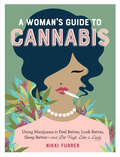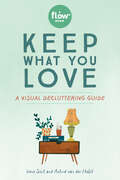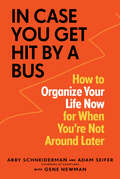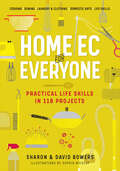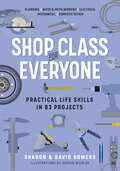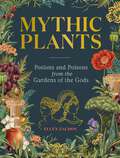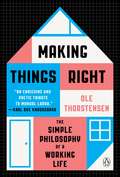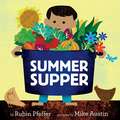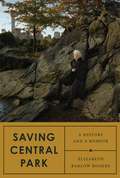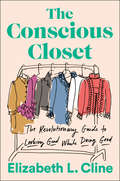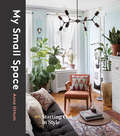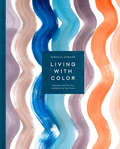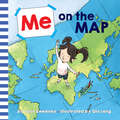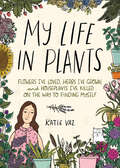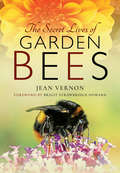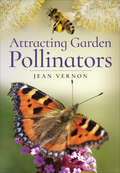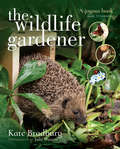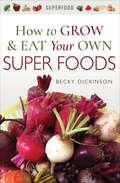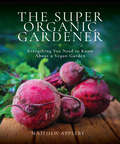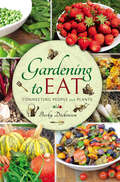- Table View
- List View
A Woman's Guide to Cannabis: Using Marijuana to Feel Better, Look Better, Sleep Better–and Get High Like a Lady
by Nikki FurrerIf you’ve heard about the self-care benefits of cannabis for pain, anxiety, and mood improvement—particularly for women—but have been overwhelmed by it all, your guide is here. Harnessing the amazing wellness properties of cannabis can make you feel and look your best. This entertaining, expert guide for women of all ages will demystify the world of weed and show you how to find just what you’re looking for—whether it’s freedom from aches and pains or a fit of giggles. Find the right dose to relieve anxiety, depression, inflammation, and mitigate signs of aging. Boost moods, even lose weight and get restful sleep. Learn how to navigate the typical dispensary, with its intimidating variety of concentrates, edibles, vape pens, and tinctures. And understand the amazing health-giving compounds found in cannabis—THC, CBD, terpenes, and more—and how to use topicals to reduce pain and give your skin a healthy glow. There’s even advice on how not to get high but still reap all the amazing health benefits. Plus there are over twenty recipes, from edibles like Netflix and Chill Caramels to self-care products like Radiant Glow Serum.
Keep What You Love: A Visual Decluttering Guide (Flow)
by Irene Smit Astrid van der Hulst Editors of Flow magazineA charming checklist for decluttering. In this whimsical yet practical guide to sorting through the too-much-stuff of modern life, the premise is simple: on each page, a delightful illustration of items that fill our lives—novelty ice cube trays, a manual typewriter, game pieces, that souvenir snow globe. And beneath each drawing, two little checkboxes: Yes and No. Look at the object. Note your response. Act accordingly! Additionally, the book is filled with dozens of tips and ideas for what to do with things that may be hard to part with, like children’s artwork. An inspiring gift!
In Case You Get Hit by a Bus: How to Organize Your Life Now for When You're Not Around Later
by Gene Newman Abby Schneiderman Adam SeiferA step-by-step program for getting your life in order, so you&’re prepared for the unexpected. The odds of getting hit by a bus are 495,000 to 1. But the odds that you&’re going to die some day? Exactly. Even the most disorganized among us can take control of our on- and off-line details so our loved ones won&’t have to scramble later. The experts at Everplans, a leading company in digital life planning, make it possible in this essential and easy-to-follow book. Breaking the task down into three levels, from the most urgent (like granting access to passwords), to the technical (creating a manual for the systems in your home), to the nostalgic (assembling a living memory), this clear, step-by-step program not only removes the anxiety and stress from getting your life in order, it&’s actually liberating. And deeply satisfying, knowing that you&’re leaving the best parting gift imaginable. When you finish this book, you will have:A system for managing all your passwords and secret codesOrganized your money and assets, bills and debtsA complete understanding of all the medical directives and legal documents you need––including Wills, Powers of Attorney, and TrustsA plan for meaningful photos, recipes, and family heirloomsRecords of your personal history, interests, beliefs, and life lessonsAn instruction manual for your home and vehiclesYour funeral planned and obituary written (if you&’re up for it)
Home Ec for Everyone: Cooking · Sewing · Laundry & Clothing · Domestic Arts · Life Skills
by David Bowers Sharon BowersDid you remember your scissors?Discover the tremendous pleasure of learning how to do it yourself how to cook, sew, clean, and more, the way it used to be taught in Home Ec class. With illustrated step by step instructions, plus relevant charts, lists, and handy graphics, Home Ec for everyone offers a crash course in learning 118 practical life skills-everything from frosting the perfect birthday cake to fixing a zipper to whitening a dingy T-shirt to packing a suitcase (the right way). It&’s all made clear in plain, nontechnical language for any level of DIYer, and it comes with a guarantee: No matter how simple the task, doing it with your own two hands provides a feeling of accomplishment that no app or device will ever give you.
Shop Class for Everyone: Plumbing · Wood & Metalwork · Electrical · Mechanical · Domestic Repair
by David Bowers Sharon BowersDid you remember your goggles?There used to be a time when pretty much every high school offered Shop class, where students learned to use a circular saw or rewire a busted lamp- all while discovering the satisfaction of being self-reliant and doing it yourself. Shop Class for Everyone now offers anyone who might have missed this vital class a crash course in these practical life skills. Packed with illustrated step by step instructions, plus relevant charts, lists, and handy graphics, here&’s how to plaster a wall, build a bookcase from scratch, unclog a drain, and change a flat tire (on your car or bike). It&’s all made clear in plain, nontechnical language for any level of DIYer, and it comes with a guarantee: No matter how simple the task, doing it with your own two hands provides a feeling of accomplishment that no app or device will ever give you.
Mythic Plants: Potions and Poisons from the Gardens of the Gods
by Ellen ZachosIn this beautifully illustrated book that's Song of Achilles meets Secret Life of Trees, readers will discover the plants cultivated by the Greek Gods–many of which can still be experimented with today–for a myriad of uses. In Greek mythology, plants were used for tools, intoxication, warfare, food, medicine, magic, and rituals. When Prometheus stole fire from the Olympian gods and gave it to mankind, he hid it in a stalk of giant fennel. Ancient Greeks waiting to question the oracles were given cannabis as part of their cleansing rituals. A quince fruit started the Trojan war. The goddess Demeter was so distraught when Hades kidnapped her daughter that she caused winter to blanket the earth, killing all plants. Mythic Plants focuses on how the ancient Greeks used plants in their lives and loves and conquests—some of which we can still use. Includes tips throughout for bringing these ancient plants into your garden.
Making Things Right: The Simple Philosophy of a Working Life
by Ole ThorstensenA celebration of craftsmanship, teamwork, and the relationship between contractor and client. "An enriching and poetic tribute to manual labour."—Karl Ove Knausgaard Making Things Right is the simple yet captivating story of a loft renovation, from the moment master carpenter and contractor Ole Thorstensen submits an estimate for the job to when the space is ready for occupation. As the project unfolds, we see the construction through Ole’s eyes: the meticulous detail, the pesky splinters, the problem solving, patience, and teamwork required for its completion. Yet Ole’s narrative encompasses more than just the fine mechanics of his craft. His labor and passion drive him toward deeper reflections on the nature of work, the academy versus the trades, identity, and life itself. Rich with descriptions of carpentry and process, Making Things Right is a warm and humorous portrayal of a tightknit working community, a story about the blood, sweat, and frustration involved in doing a job well and the joys in seeing a vision take shape.
Summer Supper
by Rubin PfefferA bold and graphic farm-to-table story, told entirely in words beginning with the letter "s"!From sowing seeds in spring to savoring succotash, follow the creation of a family meal from the farm to the picnic table on a warm summer evening. Told entirely in words beginning with the letter "s," this book will give children an appreciation for the process by which their food travels to the dinner table.Mike Austin cleverly incorporates Rubin Pfeffer's words into his art and creates a visual feast in which kids will love to indulge! Layers of humor and storytelling make this worth many revisits.
Saving Central Park: A History and a Memoir
by Elizabeth Barlow RogersThe story of how one woman's long love affair with New York's Central Park led her to organize its rescue from a state of serious decline, returning it to the beautiful place of recreational opportunity and spiritual sustenance that it is today.Elizabeth Barlow Rogers opens with a quick survey of her early life--a middle-class upbringing in Texas; college at Wellesley, marriage, a master's degree in city planning at Yale. And then her move to New York, where she starts a family and, when she finds being a mother and a housewife is not enough, pours herself into the protection and enhancement of the city's green spaces. Interwoven into her own story is a comprehensive history of Central Park: its design and construction as a scenic masterpiece; the alterations of each succeeding era; the addition of numerous facilities for sports and play; and finally, the "anything goes" phase of the 1960s and 70s, which was often fun but nearly destroyed the park. The two narratives continue to entwine as she finds a job in the administration of Central Park, founds the Central Park Conservancy, and transforms both the park and herself--a transformation that has led to the writing of her many books, to travels that have taken her to parks and gardens around the world, and to solidifying the prestige of one of New York's most conspicuous landmarks.
The Conscious Closet: The Revolutionary Guide to Looking Good While Doing Good
by Elizabeth L. ClineFrom journalist, fashionista, and clothing resale expert Elizabeth L. Cline, “the Michael Pollan of fashion,”* comes the definitive guide to building an ethical, sustainable wardrobe you'll love.Clothing is one of the most personal expressions of who we are. In her landmark investigation Overdressed: The Shockingly High Cost of Cheap Fashion, Elizabeth L. Cline first revealed fast fashion’s hidden toll on the environment, garment workers, and even our own satisfaction with our clothes. The Conscious Closet shows exactly what we can do about it. Whether your goal is to build an effortless capsule wardrobe, keep up with trends without harming the environment, buy better quality, seek out ethical brands, or all of the above, The Conscious Closet is packed with the vital tools you need. Elizabeth delves into fresh research on fashion’s impacts and shows how we can leverage our everyday fashion choices to change the world through style. Inspired by her own revelatory journey getting off the fast-fashion treadmill, Elizabeth shares exactly how to build a more ethical wardrobe, starting with a mindful closet clean-out and donating, swapping, or selling the clothes you don't love to make way for the closet of your dreams. The Conscious Closet is not just a style guide. It is a call to action to transform one of the most polluting industries on earth—fashion—into a force for good. Readers will learn where our clothes are made and how they’re made, before connecting to a global and impassioned community of stylish fashion revolutionaries. In The Conscious Closet, Elizabeth shows us how we can start to truly love and understand our clothes again—without sacrificing the environment, our morals, or our style in the process.*Michelle Goldberg, Newsweek/The Daily Beast
How to Window Box: Small-space Plants To Grow Indoors Or Out
by Chantal Aida Gordon Ryan BenoitFrom the founders of the popular gardening blog The Horticult comes a guide to the window box, the container garden that is by far the most accessible garden for any skill level, space, or quality of light. The sixteen indoor and outdoor projects range from succulents to veggies and showcase a variety of full sun- and shade-loving foliage. Bright photography and a thorough introduction to soil, watering, and plants make this great for anyone who's green to gardening.This easy gardening book shows renters and homeowners alike how they can own just a few square feet of green no matter where they live. Also included are information on choosing a window box (and instructions for building one from scratch), soil and drainage tips, and ideas for minimizing mess indoors.
My Small Space: Starting Out in Style
by Anna OttumMy Small Space is the ultimate guide to moving out on your own--whether that's in a campus dorm, an apartment with four of your friends, a two-bedroom with your buddy, or your very own studio. With photography of all kinds of spaces, smart design tips, interviews with renters, and more, this book proves that size doesn't matter when you have great style.Learn how to decorate around immovable furniture in a dorm and what to pack (and leave behind) from home. Get creative in a cramped apartrment that you share with others. If you're thinking about living solo, see what it's like to finally be in control of all of the decision making. With tips on making floor plans, picking out color palettes, hanging wall art, choosing a rug, and more, this lookbook will help you feel right at home--wherever that may be.
Living with Color: Inspiration and How-Tos to Brighten Up Your Home
by Rebecca AtwoodDiscover inspiration from the most colorful homes in America with this vibrant lookbook and style manual that brings the magic of color into your home—from the author of Living with Pattern Personalizing your color palette may be one of the most important decisions you make in your home. The right combination of hues can set the mood and transform any room from ordinary to magical. Textile designer Rebecca Atwood invites you to take a color journey in this stunning yet practical guide. In Living with Color, you’ll tour beautifully designed homes to see some of the most interesting uses of the rainbow and to gather inspiration for your own spaces. You’ll train your eye to notice how color lives all around you, from the pink light bouncing off a building you see every day to the exact blue of the ocean on your last getaway. You can even learn how to express yourself through your own custom palette with Rebecca’s accessible, illustrated overview of color theory. As you embark on your color hunt and begin to trust your own instincts, Living with Color will embolden you to breathe life into every part of your home.
Me on the Map (Me. . Books! Ser.)
by Joan SweeneyMaps can show you where you are anywhere in the world! A beloved bestseller that helps children discover their place on the planet, now refreshed with new art from Qin Leng. Where are you? Where is your room? Where is your home? Where is your town? This playful introduction to maps shows children how easy it is to find where they live and how they fit in to the larger world. Filled with fun and adorable new illustrations by Qin Leng, this repackage of Me on the Map will show readers how easy it is to find the places they know and love with help from a map.
My Life in Plants: Flowers I've Loved, Herbs I've Grown, and Houseplants I've Killed on the Way to Finding Myself
by Katie VazA &“beautifully illustrated memoir, a deeply personal remembrance about the navigation into adulthood and the plants along the way. Touching and relatable.&” (Lori Roberts, author of A Life of Gratitude) From Katie Vaz, author of Don&’t Worry, Eat Cake, the beloved Make Yourself Cozy, and The Escape Manual for Introverts, comes My Life in Plants. Her newest book tells the story of her life through the thirty-nine plants that have played both leading and supporting roles, from her childhood to her wedding day. Plants include a homegrown wildflower bouquet wrapped in duct tape that she carried on stage at age three, to a fragrant basil plant that brought her and her kitchen back to life after grief. The stories are personal, poignant, heartwarming, and relatable, and will prompt readers to recall plants of their own that have been witness to both the amazing moments of life and the ordinary ones. This illustrated memoir covers the simplicity of home, the sharpness of loss, the lesson of learning to be present, and the journey of finding your way
Every Day Is Earth Day: Simple Ways to Reduce Your Carbon Footprint
by Harriet DyerFast facts on fast fashion, throwaway plastics, and other climate catastrophes that you can do something about—today. Every Day Is Earth Day is full of simple ways to reduce your environmental impact. From tips on creating a more eco-friendly home and ways to reduce your plastic use, to advice on shopping sustainably, within these pages you will discover everything you need to know to help you make planet-friendly choices and live a more sustainable life. Also included are tips on taking it to the next level and becoming an activist—to effect wider change and encourage businesses and governments to create a future that&’s healthier, safer, and cleaner!
Villager Jim's Garden Wildlife
by Villager JimBirds, bees, and a whole host of other flora and fauna that share Villager Jims garden in the tiny Peak District village of Foolow, are featured in this stunning book of photographs. Bobbin Robin is just one of the regular visitors to the garden; she and her friends have a huge social media audience, with tens of thousands of viewers. Open up the book to see the daily goings on of these wildlife friends in some of Jims very best pictures taken in this beautiful setting. They illustrate the close relationship Jim has formed with some of the regular wildlife visitors to his garden. His quirky captions capture the mood and spontaneous character of each individual shot and are an essential element of what makes Villager Jims pictures so special.
Villager Jim's Garden Wildlife
by Villager JimBirds, bees, and a whole host of other flora and fauna that share Villager Jims garden in the tiny Peak District village of Foolow, are featured in this stunning book of photographs. Bobbin Robin is just one of the regular visitors to the garden; she and her friends have a huge social media audience, with tens of thousands of viewers. Open up the book to see the daily goings on of these wildlife friends in some of Jims very best pictures taken in this beautiful setting. They illustrate the close relationship Jim has formed with some of the regular wildlife visitors to his garden. His quirky captions capture the mood and spontaneous character of each individual shot and are an essential element of what makes Villager Jims pictures so special.
The Secret Lives of Garden Bees
by Jean VernonA friendly, accessible guide into the weird, but wonderful world of bees in the gardens of the UK.From the common or garden bumblebees that nest in bird boxes, compost heaps, and old mouse holes making “Winnie the Pooh” style honey pots to feed their babes; to the quirky wool carder bee, a solitary bee that combs the fluff from garden plants to line her brood cells; and the amazing leaf cutter bee that carves chunks out of plant foliage to seal its egg chambers . . .This book will reveal the secrets and fascinating lives of the bees that live and breed in your garden, from buzz pollination, to the bee robbers that cheat the plants and steal nectar by stealth.With a chapter per season to explore what you are likely to see in your garden, great plants to grow to help them, plus other fascinating information on these secretive creatures, this book is designed to bring alive the world of garden before your very eyes.“The colorful narrative radiates the authors love for bees and is punctuated with heaps of beautiful photographs. Easily read from cover to cover or dipped in to when in need of bee identification.” —Sunday Express (UK)
Attracting Garden Pollinators
by Jean VernonAttracting Garden Pollinators is a friendly, accessible, information packed guide to gardening for and with pollinators. Pollinators are in trouble, but our gardens can help. Gardens represent a vast, varied ‘nature reserve’ packed with plants rich in nectar and pollen to sustain these delicate creatures. This book explores the role that pollinators play and how gardeners and people with gardens can do something to help attract and support them. From butterflies (and their caterpillars - with host plant information) to surprising pollinators (moths, wasps, beetles flies and hornets) and of course including honeybees, hoverflies and bumblebees, this book will offer an insight into their fragile existence, lifecycles and their vital role in the food chain and the natural cycle. Jean Vernon is the Best-Selling author of The Secret Lives of Garden Bees.
The Wildlife Gardener: Creating A Haven For Birds, Bees And Butterflies
by Kate Bradbury Julie WatsonCreate wildlife habitats and attract birds, bees, and other creatures to your very own garden: “A must-have for any gardening library.” —Gardeners World Filled with beautiful photos, this book is a practical guide for anyone who wants to make a home for wildlife in their garden—even if they don’t have a lot of space. Divided into sections on shelter, food, and water, it includes: *advice on the best nectar and pollen plants to grow *dos and don’ts of bird feeding *information on organic methods of pest control *ten projects—with step-by-step pictures—that will help encourage wildlife, such as creating a bumblebee nester, making a green roof, and building a hedgehog box Also included is a mini field guide, which will help you identify the birds and other creatures you’re likely to spot in your garden. The Wildlife Gardener gives tips on particular species, explaining what to look out for and how to cater for specific birds, mammals, bees, butterflies, moths, and pond life. “A joyous book.” —Alan Titchmarsh, author of My Secret Garden
How to Grow & Eat Your Own Superfoods (Superfood)
by Becky DickinsonA step-by-step guide to planting your own fruit and vegetable garden—and growing your own healthy and nutritious superfoods. Gardening is where science meets art, where nature meets nurture and where food and health unite. In an age of clean eating and fad diets, the term superfood has become synonymous with inflated prices and overstated claims about the disease-fighting, anti-aging, life-enhancing powers these foods possess. Sales of fruits and vegetables like kale, beetroot, and blueberries have skyrocketed, encouraging us to spend money on products that have traveled miles around the country or even the globe only to sit in a supermarket wrapped in plastic for days. Becky Dickinson&’s How to Grow & Eat Your Own Superfoods weeds out the hype and unearths the secrets of what makes a food super. Discover a wide array of fruits and vegetables all with their own super qualities, and learn how to sow and plant them yourself, free from chemicals and full of goodness. In the comprehensive A to Z directory of crops, you&’ll find nutritional information for all kinds of fruits and vegetables, followed by practical advice for planting and growing, plus mouthwatering recipes for making the most of your harvest. Experience the delight of following your food&’s journey from seed to plate, and the gratification of picking and eating your own produce. Indulge your taste buds with tasty, nutritious meals by taking control of what you eat and growing your way to better health.
The Super Organic Gardener: Everything You Need to Know About a Vegan Garden
by Matthew ApplebyIf you care about what you eat, you should care about how you grow it.Gardeners can demonstrate that by going beyond organics to veganics - growing without animal inputs - they are a driving force in saving the environment.This book gives you the tools to grow without harming the planet and animals, and explains why moving beyond organics towards super organic vegan gardening is the way to show you are genuinely concerned about environmental issues and the industrial commodification of living, sentient creatures.From advice about how to make and buy natural fertilisers and compost, to putting nutritional values on what you grow, and to how to cook it, and how to share your plot with wildlife, this book covers all the bases.The foreword is by RHS Chelsea Flower Show best in show winner Cleve West, who is a passionate vegan gardener. Vegan Organic Network and Garden Organic have backed the book too.
The Super Organic Gardener: Everything You Need to Know About a Vegan Garden
by Matthew ApplebyIf you care about what you eat, you should care about how you grow it.Gardeners can demonstrate that by going beyond organics to veganics - growing without animal inputs - they are a driving force in saving the environment.This book gives you the tools to grow without harming the planet and animals, and explains why moving beyond organics towards super organic vegan gardening is the way to show you are genuinely concerned about environmental issues and the industrial commodification of living, sentient creatures.From advice about how to make and buy natural fertilisers and compost, to putting nutritional values on what you grow, and to how to cook it, and how to share your plot with wildlife, this book covers all the bases.The foreword is by RHS Chelsea Flower Show best in show winner Cleve West, who is a passionate vegan gardener. Vegan Organic Network and Garden Organic have backed the book too.
Gardening to Eat: Connecting People and Plants
by Becky DickinsonEmbrace a plant-based lifestyle all the way from seed to plate. This inspiring and informative book takes the mystery out of gardening and reveals how to grow an array of fruits and vegetables using simple, organic techniques. Packed with fresh ideas for turning homegrown produce into delicious, nutritious meals, you'll find heaps of no-nonsense recipes created for real people with busy lives and healthy appetites. No fads, no fuss, no fancy ingredients, just real, honest, ethical food. With a passion for connecting people and plants, Gardening to Eat brings the garden into the kitchen. For people who love food and love to know where it's come from.
